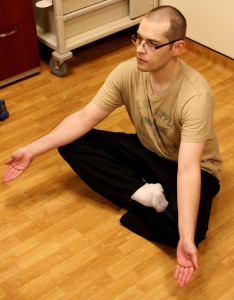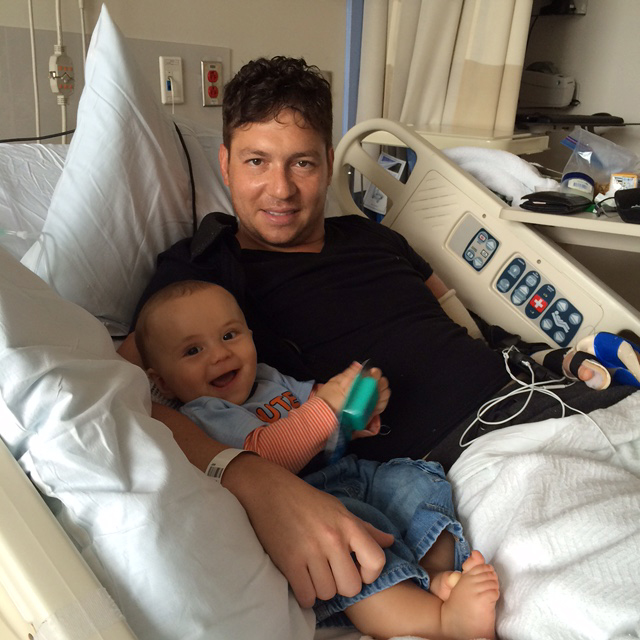WASHINGTON — Capt. James Sears may be the future of pain management.
The Army nurse was injured in a bus crash in 2007 while on his way to a domestic training mission in South Dakota. The driver fell asleep at the wheel and hit a bridge, leaving Sears with damage to his back and left hip — and the possibility of a lifetime of chronic pain.
“I actually did become dependent on the medication I took,” says Sears, adding that addiction to opioid painkillers is a problem facing too many, both in and out of the military.

As time passed, he saw others benefit from a set of alternative pain management techniques that are being tested by the military medical system to help both active duty members of the armed services and veterans.
Gradually, he began to try different options available through the pain management program at Walter Reed National Military Medical Center in Bethesda — from acupuncture, to yoga, to mind-body wellness.
“Mind and body wellness takes into account your mind is a big part of healing a person as a whole,” says Sears, who adds that distracting or calming the mind can “help immensely.”
His reliance on strong painkillers is gone, having been replaced by this basket of alternative therapies.
“I do like yoga, but mind and body wellness and acupuncture do wonders for me, and I love them and can’t do without them,” Sears says.
It’s a modern approach that uses ancient techniques — and experts at Walter Reed say it’s working.
“We have the science now that is backing it that we didn’t even have 20 years ago,” says Dr. Christopher Spevak, prescription medication misuse director at Walter Reed and deputy director of the Wounded Warrior Pain Care Initiative.
He says patients such as Sears are taught a variety of skills that they can use to manage their pain. Some are as simple as using the smell of peppermint to train the brain and wean it off prescription painkillers.
“We can give people the smell of peppermint every time they take their pill,” Spevak says. In time, the scent has the same effect as the medication.
“I love it because the common sense things are what our grandmothers told us,” he adds.
Today, modern brain imaging offers proof that grandma was right.
Movement is another effective tool Walter Reed uses to help manage chronic pain; the intensity is determined by the overall physical condition of the patient.
Sears, for example, started out with yoga instruction adapted for his injuries. He says he gradually became more limber, and perhaps more importantly, he began to realize “it can bring you peace.”
Spevak says yoga can be extremely beneficial, but notes it is not for everyone. He says for older veterans — particularly those from the Korean and Vietnam War eras — the most popular form of physical activity incorporated in pain management is ballroom dancing.
“Ballroom dancing requires so much conductivity to the brain, listening to the music, the steps and things like that, that we can make that brain fire less pain,” Spevak explains.
That is also the premise behind the rising use of ancient Chinese forms of exercise that use flowing, gentle movements, such as tai chi and qigong.
Elmer Lee, a physical therapist at the McGuire Veteran’s Hospital in Richmond, Virginia, has been teaching these exercises to his patients, and was recently brought to Walter Reed to share his knowledge at a seminar on alternative pain management for military health care personnel from around the world.
Lee says health care professionals are no longer looking at pain as a problem to be treated with drugs, injections or surgery. He finds that teaching disciplines, such as tai chi and qigong, to patients through veteran and military hospitals — rather than classes open to the public — makes the therapies even more powerful pain management tools. Camaraderie is the not so secret ingredient.
“Sharing past histories, being part of a team, being part of a common goal for better health awareness, all play a role,” Lee says.
This united spirit is one reason why the military medical system is uniquely qualified to lead the way on alternative pain management.
“We have been developing programs that have never been seen in the civilian sector,” says Spevak, acknowledging that the task of caring for the wounded warriors of recent conflicts has given added impetus to this work.
Sears has experienced the results firsthand, coming back from a dangerous reliance on opioids with new resolve.
“My dream is to go on and get my nurse practitioner degree and specialize in addiction treatment and help those who are going through what I went through before,” he says.
In this way, he believes, his experience will help others. And as a military veteran, he will continue to serve.







